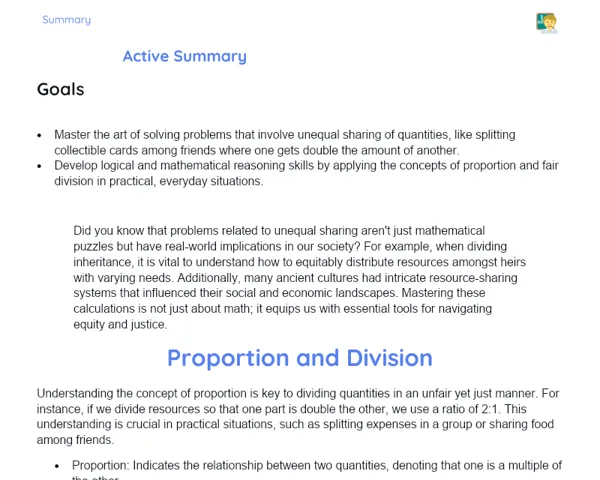Socioemotional Summary Conclusion
Goals
1. Grasp the concept of mathematical functions, emphasizing the relationship between inputs and outputs.
2. Enhance problem-solving skills for calculating inputs and outputs of functions through hands-on exercises.
3. Acknowledge and manage emotions during math learning by employing techniques like mindful breathing and emotional reflection.
Contextualization
Did you know that dedicating time to your studies can significantly influence your overall academic success? Much like a thermostat that controls a room’s temperature, mathematical functions help us comprehend how changes in one variable can impact another. Let’s dive into this intriguing realm together and see how we can apply these ideas in our everyday lives!
Exercising Your Knowledge
Definition of Function
A function represents a special connection between two groups where each element from the first group (input) pairs with exactly one element from the second group (output). This concept is fundamental in understanding various daily scenarios, such as figuring out how long to study to reach a particular academic target.
-
Each input yields a unique output: For every value of x (input), there exists a corresponding value of f(x) (output).
-
Notation: We denote this relationship with f(x). For example, if x = 3, then f(3) gives us the respective output value.
-
Practical Utility: Common examples include temperature conversions and financial assessments. Understanding functions aids in making informed choices.
Representations of Functions
Functions can be depicted in several formats, such as equations, tables, and graphs. Each representation provides a different viewpoint and can simplify the solving of specific issues.
-
Equations: A straightforward approach to understanding the relationship between input and output. Example: f(x) = 2x + 3.
-
Tables: Great for quickly visualizing several inputs and their corresponding outputs.
-
Graphs: Offer a visual and intuitive representation of functions, especially beneficial for spotting trends and behaviours of more complex functions.
Inputs and Outputs of Functions
Inputs (or domain) are the values you feed into the function, while outputs (or range) are the results you derive. Comprehending this interchange is vital for tackling mathematical problems and making accurate predictions.
-
Domain: All potential values of x that can be inputted into the function.
-
Range: All possible outcomes of f(x) that the function can yield.
-
Application: Helps in understanding how variations in an initial value (input) influence the final outcome (output), promoting more responsible and informed decision-making.
Key Terms
-
Function
-
Input (Domain)
-
Output (Range)
-
Equation
-
Table
-
Graph
-
Linear Function
-
Non-Linear Function
For Reflection
-
How can you incorporate the concept of functions into your daily life? Reflect on a practical example.
-
What emotions do you experience while tackling function problems? How do these emotions affect your performance?
-
Which emotional regulation tactics can you employ to enhance your focus and performance in math?
Important Conclusions
-
Grasping the concept of mathematical functions is key to solving everyday challenges and making informed decisions.
-
The skill to compute inputs and outputs of functions nurtures logical and analytical reasoning.
-
Learning to identify and manage emotions during studies is paramount for boosting academic performance and personal confidence.
Impacts on Society
Mathematical functions pervade various facets of our lives. For instance, when you use a navigation app, it applies functions to determine the fastest route to your destination. Understanding these functions empowers you to make well-informed choices regarding which route to select and the estimated time of arrival.
On an emotional level, being able to comprehend and compute functions fosters a sense of control and self-belief. This equips us to tackle challenges more smoothly and make decisions thoughtfully and responsibly. Additionally, regulating our emotions during learning can significantly reduce stress and anxiety, rendering the process more enjoyable and effective.
Dealing with Emotions
To manage your emotions while studying mathematical functions, consider following the RULER method. Start by recognizing how you feel when confronted with a math problem. Understand the reasons behind these emotions and their impact on your performance. Accurately label your feelings, be it 'frustration' or 'satisfaction'. Communicate these emotions appropriately, perhaps by discussing with a peer or journaling. Lastly, adjust your emotions using techniques like mindful breathing or taking short breaks during study. This approach will help you stay focused and composed, ultimately enhancing your learning experience and overall well-being.
Study Tips
-
Dedicate 30 minutes daily to practice calculating functions to solidify your understanding.
-
Incorporate mindful breathing techniques before tackling math problems to boost focus and ease.
-
Participate in study groups to discuss and solve problems collectively, enabling the sharing of strategies and overcoming challenges together.



